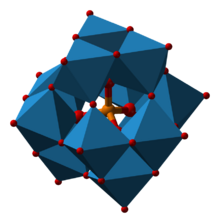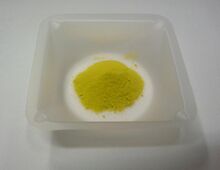Chemistry:Phosphomolybdic acid

| |

| |
| Names | |
|---|---|
| Other names
Molybdophosphoric acid; dodecamolybdophosphoric acid
| |
| Identifiers | |
| |
3D model (JSmol)
|
|
| ChemSpider | |
| EC Number |
|
| MeSH | Phosphomolybdic+acid |
PubChem CID
|
|
| UNII | |
| |
| |
| Properties | |
| H 3[PMo 12O 40] | |
| Molar mass | 1825.25 g/mol |
| Density | 1.62 g/ml[1] (hydrate) |
| Melting point | 79-90 °C[1] |
| soluble | |
| Hazards | |
| Main hazards | Oxidiser[1] (hydrate) |
Except where otherwise noted, data are given for materials in their standard state (at 25 °C [77 °F], 100 kPa). | |
| Infobox references | |
Phosphomolybdic acid is the heteropolymetalate with the formula H
3[Mo
12PO
40] · 12H2O. It is a yellow solid, although even slightly impure samples have a greenish coloration. It is also known as dodeca molybdophosphoric acid or PMA, is a yellow-green chemical compound that is freely soluble in water and polar organic solvents such as ethanol. It is used as a stain in histology and in organic synthesis.[2]
Histology
Phosphomolybdic acid is a component of Masson's trichrome stain.[3]
Organic synthesis
Phosphomolybdic is used as a stain for developing thin-layer chromatography plates,[4] staining phenolics, hydrocarbon waxes, alkaloids, and steroids. Conjugated unsaturated compounds reduce PMA to molybdenum blue. The color intensifies with increasing number of double bonds in the molecule being stained.[5]
Phosphomolybdic acid is also occasionally used in acid-catalyzed reactions in organic synthesis. It has been shown to be a good catalyst for the Skraup reaction for the synthesis of substituted quinolines.[6]
See also
- Phosphotungstic acid[2]
- Folin-Ciocalteu reagent
References
- ↑ 1.0 1.1 1.2 "Phosphomolybdic acid hydrate - Safety data sheet" (PDF). 2016-07-18. https://www.sigmaaldrich.com/MSDS/MSDS/PrintMSDSAction.do?name=msdspdf_1810279065542294.
- ↑ 2.0 2.1 Dias, J. A.; Dias, S. C. L.; Caliman, E. (2014). "Keggin Structure Polyoxometalates". Inorganic Syntheses: Volume 36. Inorganic Syntheses. 36. p. 210-217. doi:10.1002/9781118744994.ch39. ISBN 9781118744994.
- ↑ "Masson's Trichrome for Muscle and Collagen". StainsFile. http://stainsfile.info/StainsFile/stain/conektv/masson.htm.
- ↑ "Stains for Developing TLC Plates". McMaster University. https://www.chemistry.mcmaster.ca/adronov/resources/Stains_for_Developing_TLC_Plates.pdf.
- ↑ Burstein, Shlomo (1953). "Reduction of Phosphomolybdic Acid by Compounds Possessing Conjugated Double Bonds". Analytical Chemistry 25 (3): 422–424. doi:10.1021/ac60075a012. ISSN 0003-2700.
- ↑ Chaskar, Atul; Padalkar, Vikas; Phatangare, Kiran et al. (2010). "Miceller-Mediated Phosphomolybdic Acid: Highly Effective Reusable Catalyst for Synthesis of Quinoline and Its Derivatives". Synthetic Communications 40 (15): 2336–2340. doi:10.1080/00397910903245141. ISSN 0039-7911.
 |
